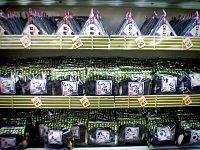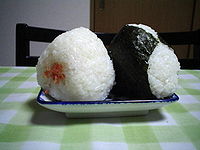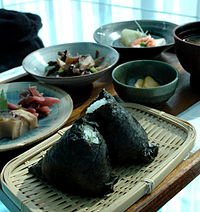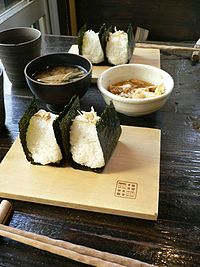- Onigiri
-
Onigiri (お握り or 御握り; おにぎり), also known as omusubi (お結び; おむすび) or rice ball, is a Japanese food made from white rice formed into triangular or oval shapes and often wrapped in nori (seaweed). Traditionally, an onigiri is filled with pickled ume (umeboshi), salted salmon, katsuobushi, kombu, tarako, or any other salty or sour ingredient as a natural preservative. Because of the popularity of onigiri in Japan, most convenience stores stock their onigiri with various fillings and flavors. There are even specialized shops whose only products are onigiri for take out.
Contents
Overview
 Onigiri at a convenience store in Kamakura
Onigiri at a convenience store in Kamakura
Despite common misconceptions, onigiri is not a form of sushi. Onigiri is made with plain rice (sometimes lightly salted), while sushi is made of rice with vinegar, sugar and salt.[1] Onigiri makes rice portable and easy to eat as well as preserving it, while sushi originated as a way of preserving fish.
Onigiri are also found in many convenience stores in Hong Kong, mainland China, Taiwan and South Korea. In Korean, it is called "jumeok bap" (Hangul: 주먹밥) or "samgak gimbap" (Hangul: 삼각김밥), literally "fist-rice" or "triangle-seaweed-rice," respectively.[2][3][4][5]
History
In Lady Murasaki's 11th-century diary Murasaki Shikibu Nikki, she writes of people eating rice balls.[6][7] At that time, onigiri were called tonjiki and often consumed at outdoor picnic lunches.[8] Other writings, dating back as far as the seventeenth century, state that many samurai stored rice balls wrapped in bamboo leaves as a quick lunchtime meal during war, but the origins of onigiri are much earlier even than Lady Murasaki. Before the use of chopsticks became widespread, in the Nara period, rice was often rolled into a small ball so that it could be easily picked up. In the Heian period, rice was also made into small rectangular shapes known as tonjiki so that they could be piled onto a plate and easily eaten.
From the Kamakura period to the early Edo period, onigiri was used as a quick meal. This made sense as cooks simply had to think about making enough onigiri and did not have to concern themselves with serving. These onigiri were simply balls of rice flavored with salt. Nori did not become widely available until the Genroku era in the mid-Edo period, when the farming of nori and fashioning it into sheets became widespread.
It was believed that onigiri could not be mass produced as the hand-rolling technique was considered too difficult for a machine to replicate.[who?] In the 1980s, however, a machine that made triangular onigiri was devised. This was initially met with skepticism because, rather than having the filling traditionally rolled inside, the flavoring was simply put into a hole in the onigiri, and the hole was hidden by nori. Since the onigiri made by this machine came with nori already applied to the rice ball, over time the nori became unpleasantly moist and sticky, clinging to the rice. A packaging improvement allowed the nori to be stored separately from the rice. Before eating, the diner could open the packet of nori and wrap the onigiri. The limitation of the machines that required using a hole for filling the onigiri instead of rolling the filling with the rice actually made new flavors of onigiri easier to produce as this cooking process did not require changes from ingredient to ingredient. Modern mechanically wrapped onigiri are specially folded so that the plastic wrapping is actually folded between the nori and rice to act as a moisture barrier. When the packaging is pulled open at both ends, the nori and rice come into contact.
See also
Notes
- ^ Murata, Yoshihiro; Kuma, Masashi; Adrià, Ferran (2006). Kaiseki: the exquisite cuisine of Kyoto's Kikunoi Restaurant. Kodansha International. p. 162. ISBN 4770030223. http://books.google.com/books?id=8clwyPUpULQC&pg=PA162&dq=%22sushi+vinegar%22#v=onepage&q=%22sushi%20vinegar%22&f=false.
- ^ "Japanese food" (in Korean). Dusan Encyclopedia. http://www.encyber.com/travelworld/theme.php?masterno=559233. Retrieved 21 February 2008. "오니기리(お握り)는 우리나라의 주먹밥과 매우 비슷하다. 밥에 소금으로 간을 하고, 그것에 다양한 재료를 섞어 넣고 삼각형으로 뭉친 것이다. 그것을 김으로 둘러서 먹는데, 한국에는 삼각김밥이라는 이름으로 들어와 있다."
- ^ 農林水産省 平成14年度 貿易情報海外調査報告書「韓国における食品マーケットの変化と可能性
- ^ コリアンビジネスネットワーク 韓国ニュース韓国「おにぎりブーム」仕掛け人は本多さん(元記事;2001年8月21日 朝日新聞)
- ^ コリアンビジネスネットワーク 韓国ニュース日本式三角おにぎりがコンビニを制覇
- ^ Ikeda (1958:455)
- ^ Hasegawa (1989:266)
- ^ A Taste of Japan, Donald Richie, Kodansha, 2001, ISBN 4770017073
References
- Hasegawa, Masaharu; Yūichirō Imanishi (1989). Shin Koten Bungaku Taikei 24: Tosa Nikki, Kagerō Nikki, Murasaki Shikibu Nikki, Sarashina Nikki. Tōkyō: Iwanami Shoten. ISBN 4-00-240024-7.
- Ikeda, Kikan; Shinji Kishigami, Ken Akiyama (1958). Koten Bungaku Taikei 19: Makura no Sōshi, Murasaki Shikibu Nikki. Tōkyō: Iwanami Shoten. ISBN 4-00-060019-2.
External links
Categories:- Japanese cuisine
- Rice dishes
Wikimedia Foundation. 2010.



